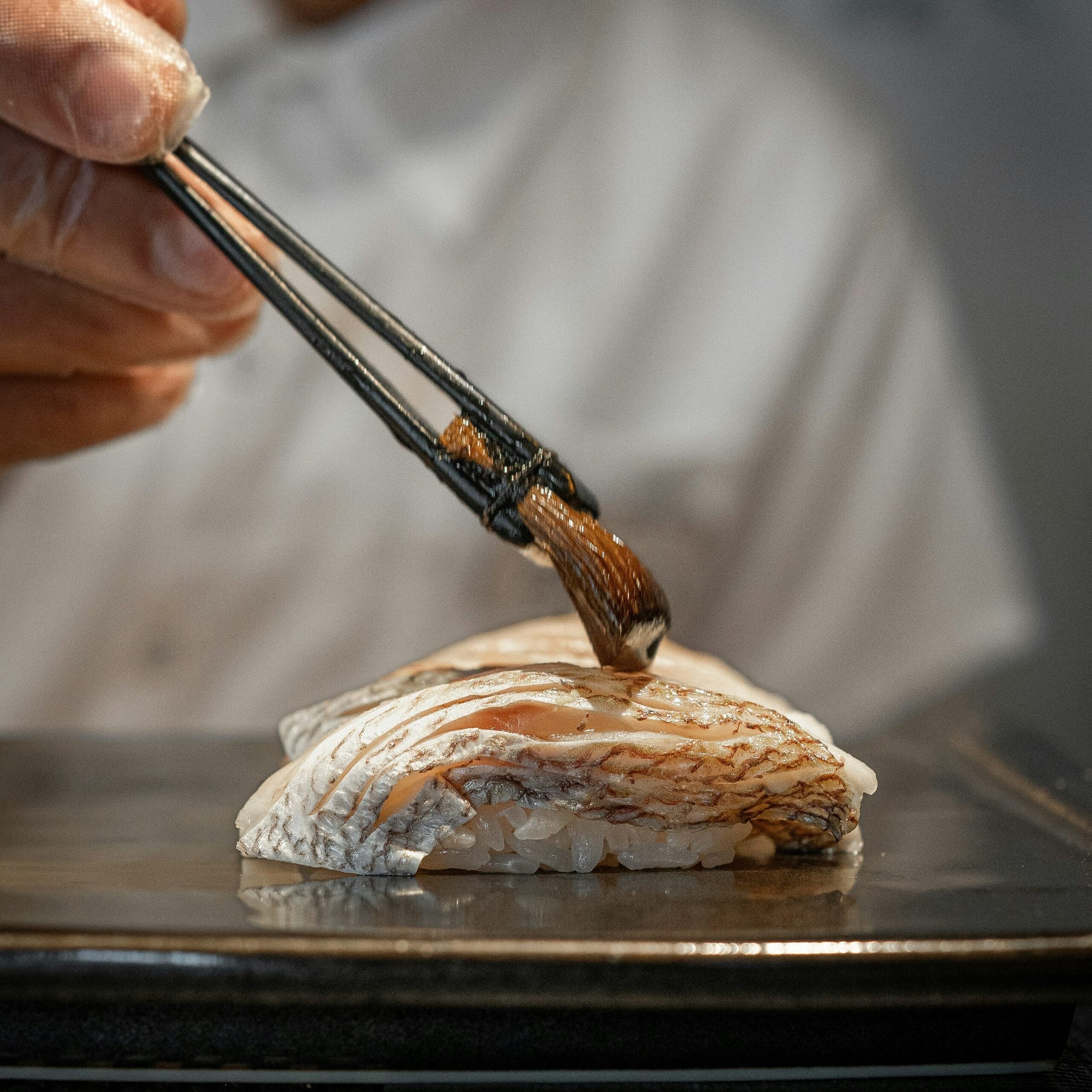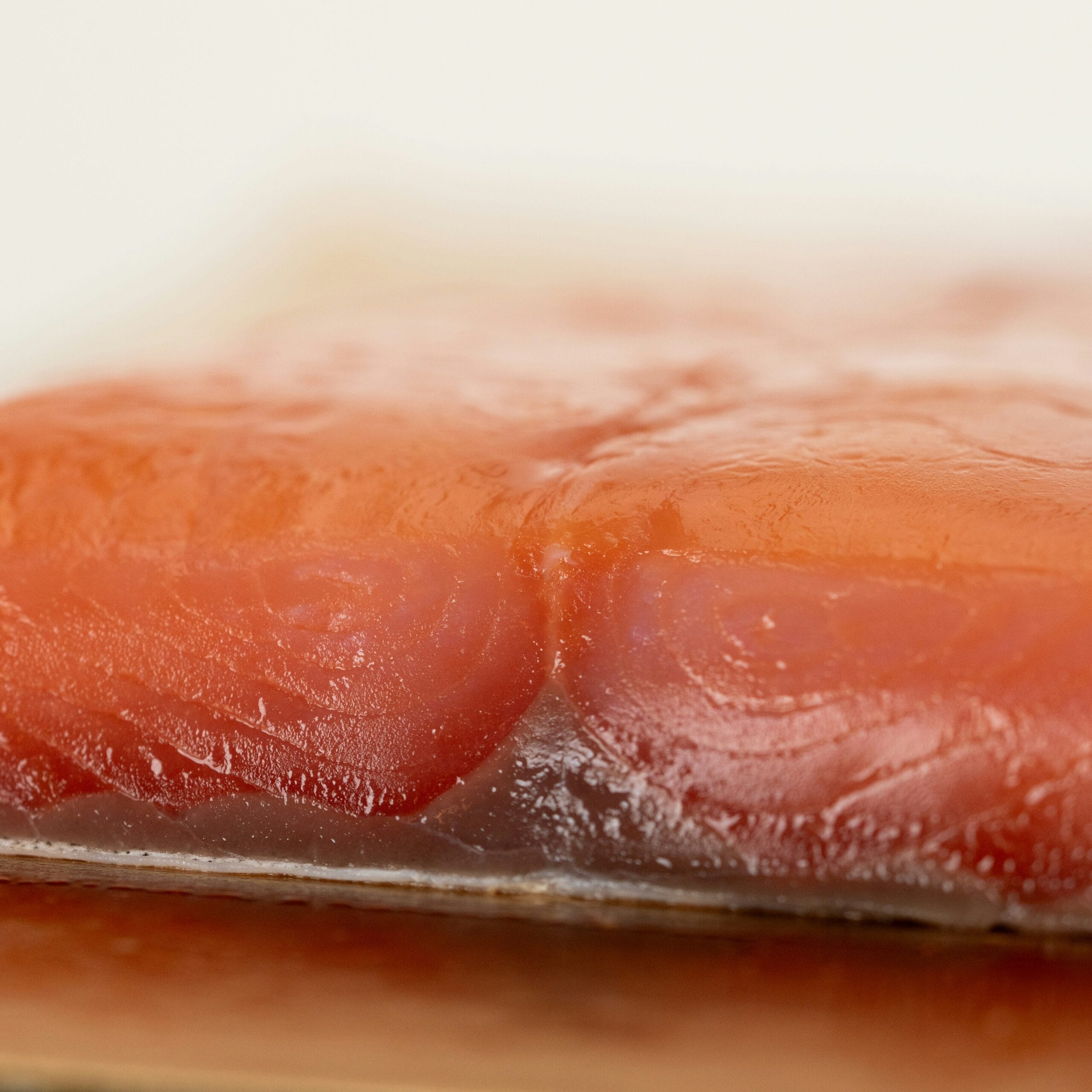
“Surely the dry-ageing is one of my favourite techniques, it completely changed the way I appreciate seafood and I can’t get enough of it.” Dry-ageing enhances the taste of fish by intensifying its natural flavours, improving texture, and reducing excess moisture. The process relies on controlled temperature, humidity, and airflow to allow natural enzymatic and microbial activity to develop a richer, more complex taste.
Now, I love experimenting with the technique, carefully selecting the freshest fish, letting time work its magic, and tasting how each variety develops its own unique character. It’s like unlocking hidden layers of the sea, one bite at a time.” Removing excess water, enhancing umami compounds, and improving texture, dry ageing transforms fish into a more flavourful, refined product. It eliminates unwanted odours, deepens natural sweetness, and creates a luxurious mouthfeel, making it an increasingly popular technique among chefs and seafood enthusiasts.
The Science Behind Dry-Ageing Fish
Moisture Reduction & Flavour Concentration.
Fresh fish contain a high percentage of water, which can dilute their flavour. As the fish dry ages, some of this moisture evaporates, leading to a more concentrated, umami-rich taste.
Enzymatic Breakdown
Fish contain natural enzymes that continue breaking down proteins and fats after being harvested.
This enzymatic activity creates free amino acids like glutamate, enhancing the fish’s savoury, umami profile.
The result is a deeper, more nuanced flavour without the strong “fishy” taste of ageing spoilage.
Textural Changes
The drying process firms up the flesh, making it more structured and less watery.
This improved texture is especially noticeable in raw preparations like sashimi, where the fish becomes silkier and more luxurious on the palate.
Reduction of Fishy Odours
When fresh fish ages improperly, bacteria break down trimethylamine oxide (TMAO) into trimethylamine (TMA), causing the “fishy” smell.
Dry ageing allows slow dehydration and controlled bacterial activity, preventing this rapid breakdown and leading to a cleaner, fresher aroma.
Crispier Skin When Cooked
Since the skin loses moisture during dry ageing, it crisps up more effectively when seared or roasted, providing a satisfying contrast to the tender flesh.

Hanging fish is one of the best techniques for dry-ageing, as it ensures even air circulation around the entire fish, promoting surface drying without moisture accumulation.
How to Hang Fish for Dry-Ageing
1. Choosing the Hanging Method
There are two main ways to hang fish:
By the tail (most common method) or through the gills (less common but suitable for some fish)
2. Preparing the Fish
Do not scale: The scales protect the flesh from excessive dehydration.
Gut the fish completely: Remove all internal organs and blood.
Pat dry with paper towels before hanging to remove excess moisture.
3. Hanging Techniques
By the tail:
- Use a stainless steel hook or food-safe string.
- Insert the hook between the tail bones, ensuring it does not tear the flesh.
- Hang the fish in a refrigerator with good air circulation (ideally a dry-ageing fridge).
Through the gills:
- Thread food-safe string or a hook through the gills and out of the mouth.
- This method works better for medium-sized fish with a strong skull structure.
Proper airflow is essential to ensure even drying and to prevent moisture buildup, which can lead to unwanted bacterial growth. A built-in fan in a dry-ageing fridge provides continuous air circulation. If using a standard refrigerator, adding a small external fan can help improve airflow and mimic the conditions of a professional dry-ageing setup. Good air circulation allows the fish to develop a dry outer layer that protects the flesh while concentrating flavours.
Before talking about dry-ageing, it is important to know how types of fish are classified.
Fatty fish
Salmon – One of the most popular fatty fish, known for its rich, slightly sweet flavour and firm texture.
Tuna – Varieties like bluefin and yellowfin have a deep, meaty taste and are excellent for grilling or eating raw.
Mackerel – Strongly flavoured and high in oils, it’s great for smoking, grilling, or pickling.
Sardines – Small but packed with flavour and healthy fats, often enjoyed grilled, canned, or in Mediterranean dishes.
Trout – A milder alternative to salmon, ideal for pan-searing, baking, or smoking.
Herring – Often pickled, smoked, or grilled, it has a bold taste and high oil content.
Black Cod (Sablefish) – Exceptionally buttery and flaky, great for slow-roasting or miso-glazing.
Lean fish
Haddock – Slightly sweeter than cod, commonly used in fish and chips or soups.
Flounder – Soft and delicate, ideal for pan-frying or baking with light sauces.
Sole – Extremely tender, often prepared meunière-style with butter and lemon.
Tilapia – Neutral-flavoured, versatile, and good for grilling or baking.
Snapper – Firm but lean, works well for roasting, grilling, or ceviche.
Halibut – A firmer, lean fish that holds up well to grilling and roasting.
Cod – Mild and flaky, great for baking, frying, or steaming.
Grouper – Mild and meaty, commonly used in sandwiches, grilling, or baking.
Delicate fish
Flounder – A mild, slightly sweet fish with a fine texture, perfect for sautéing or baking.
Sole – Very delicate and flaky, commonly prepared meunière-style (pan-fried with butter and lemon).
Cod – Soft and flaky, it holds up well to poaching, steaming, or gentle roasting.
Haddock – Similar to cod but with a finer texture, excellent for soups and light frying.
Tilapia – A neutral-flavoured fish that absorbs seasonings well, often baked or grilled gently.
Sea Bass – Mild, buttery, and tender, ideal for steaming or pan-searing with crisped skin.
John Dory – Firm yet delicate, often served with light sauces to enhance its natural sweetness.
Oily fish
Salmon – Buttery and rich, perfect for grilling, roasting, or eating raw.
Tuna – Meaty and flavourful, great for searing, sushi, or tartare.
Mackerel – Bold, slightly briny, and excellent for grilling or smoking.
Sardines – Small but packed with flavour, often grilled, canned, or pickled.
Herring – Strongly flavoured and typically pickled or smoked.
Anchovies – Intense umami flavour, commonly used in sauces, pastes, or as a topping.
Trout – A milder oily fish, great for pan-frying, baking, or smoking.
Black Cod (Sablefish) – Exceptionally rich and buttery, often roasted or marinated in miso.

Here’s an overview of how to adjust the dry-ageing process for various types of fish:
Fatty Fish
Temperature: Fatty fish, with their rich oil content, are better suited to slightly warmer ageing conditions. The ideal temperature range for these fish is typically 34°F to 38°F (1°C to 3°C). These fish can handle a bit more warmth without losing too much moisture, helping the ageing process move along smoothly. Some chefs may even experiment with temperatures closer to 40°F (4°C), depending on the fat level, though care should be taken not to go too high.
Humidity: These fish require a moderate to high humidity range, usually between 80% and 85%, to maintain their moisture levels while the ageing process develops their flavours. Too low humidity can cause them to dry out, while overly high humidity may create conditions conducive to spoilage.
Ageing Time: Fatty fish are resilient during the ageing process, and they can be aged for at least 5 to 7 days or even longer, depending on the desired flavour intensity. Their fat helps preserve moisture, allowing for a longer ageing period.
Lean fish
Temperature: Lean fish have less fat to retain moisture, so they need to be stored at slightly cooler temperatures to prevent rapid moisture loss. A temperature range of 34°F to 36°F (1°C to 2°C) is ideal for these types of fish, as it slows down the ageing process, keeping the fish fresh without over-drying it.
Humidity: With lean fish, the humidity needs to be kept lower, typically between 75% and 80%, to prevent the fish from becoming overly soft or spoiled. Because they lack the fat reserves of other species, lean fish are more sensitive to humidity, and excessive moisture can result in mushiness.
Ageing Time: Due to their lean nature, these fish should not be aged for too long—2 to 4 days is typically enough. Prolonged ageing will result in dry, tough fish, so regular checks and tastings are necessary to monitor the development of flavour and texture.
Delicate fish
Temperature: These fish are known for their fragile texture and require very cool, stable temperatures for ageing. The optimal temperature for delicate fish is around 34°F (1°C), as this helps to preserve their light texture without causing degradation or mushiness.
Humidity: Delicate fish perform best in lower humidity levels, typically between 70% and 75%, to avoid becoming too soft. With their delicate structure, too much moisture can cause them to lose their texture quickly, so it’s important to find the right balance.
Ageing Time: These fish should only be aged for 2 to 3 days. The shorter ageing period prevents them from becoming overly fragile or deteriorating in quality. Regular tastings are essential to gauge when they reach their peak flavour and texture.
Oily fish
Temperature: Oily fish have high-fat content, which, while flavourful, can quickly turn rancid if not aged properly. To protect the oils from oxidising, these fish should be stored at very cool temperatures, between 32°F and 34°F (0°C to 1°C). This helps prevent the oils from breaking down too quickly, which would negatively affect the taste.
Humidity: Oily fish require lower humidity as well, usually around 70% to 75%, to prevent excess moisture from interacting with the oils and leading to spoilage. High humidity can encourage the growth of bacteria, so it’s important to keep the humidity in check.
Ageing Time: These fish should only be aged for 2 to 3 days due to their high oil content. Ageing them any longer could lead to unpleasant, rancid flavours from the oils breaking down. Regular monitoring and tasting are crucial to ensure they are fresh and flavourful.
Quick Summary of Dry-Ageing Conditions:
| Fish Type | Temperature | Humidity | Aging Time |
| Fatty Fish | 34°F to 38°F (1°C to 3°C) | 80-85% | 5-7 days |
| Lean Fish | 34°F to 36°F (1°C to 2°C) | 75-80% | 2-4 days |
| Delicate Fish | 34°F (1°C) | 70-75% | 2-3 days |
| Oily Fish | 32°F to 34°F (0°C to 1°C) | 70-75% | 2-3 days |
By carefully managing both temperature and humidity for each species, you can ensure the fish reaches its optimal flavour and texture. Regular tastings during the ageing process are crucial to finding the perfect balance and ensuring the best possible result.
The ageing time also depends on how dry you prefer the fish to be. The longer the fish ages, the more moisture evaporates, resulting in a firmer texture and concentrated flavours. If you prefer a slightly drier, more intense flavour, you’ll want to age the fish for a longer period (up to several weeks). On the other hand, if you prefer the fish to maintain a milder flavour and softer texture, a shorter ageing period may be ideal. The balance between dryness and moisture content will significantly impact both the flavour profile and texture of the final product.
Note: Since the dry-ageing process can be influenced by various factors, it’s important to sample the fish daily to observe its progress. Every type of fish responds differently to ageing, and some may develop multiple bursts of flavour as they mature. Regular tastings are key to determining the ideal moment for consumption.

Sources:
“The Seafood Handbook: The Comprehensive Guide to Sourcing, Cooking, and Eating Sustainable Fish and Shellfish” by the editors of Seafood Watch
“Fish and Shellfish: A Comprehensive Guide to the Fish and Shellfish of the World” by Ian McSweeney
“The whole fish” cookbook Josh Niland
